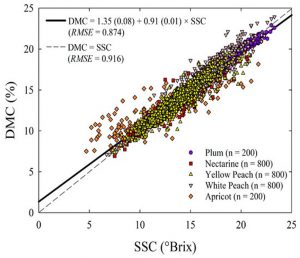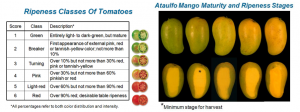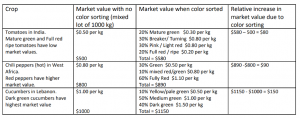- Quality control throughout the process of precision horticulture is vital to maximizing efficient food production.
- Five quality parameters are regularly relied upon for the most accurate assessment of produce quality: dry matter, soluble sugars, titrable acidity, color, and firmness.
- These parameters act as maturity index and can optimize quality and yield in the supply chain by aiding in sorting, grading, packaging, and retailing in the post-harvest stages.
- Efficient produce quality management can be achieved with modern tools.
From the field to the packing house, quality control of perishable fresh produce is vital. Yield-optimizing microvariations in farming techniques and QA management throughout the supply chain require efficient quality control tools. Precision horticulture leverages miniaturized technology for non-destructive collection of fruit-specific data along with chemometric analysis to help monitor quality. Armed with this information stakeholders are able to make informed decisions, improve management practices in the supply chain, boost yield and strengthen quality. Meeting consumer needs and reducing rejection loss increases not only profits, but horticulture’s sustainability and contribution to global food security.
Produce quality is complex. It is characterized by many traits, like taste, color, shape, size, texture, and nutraceutical content. The five most important quality parameters commonly used for decision-making in fresh produce quality control are discussed below.
1. Dry Matter (DM)
Dry matter (DM) is a representation of the total solids in fruit or plant organs. It consists of carbohydrates, proteins, starches, oils, sugars, antioxidants, pigments, nutraceuticals, fiber, etc. Dry matter is calculated as the weight of a fruit minus its water content.
Dry matter is the latest quality parameter to be used in the produce quality control industry. It is gaining importance over more traditional parameters like firmness, and color, for several reasons.
- Dry matter measurement predicts post-harvest ripeness as it includes starches that convert into sugars after ripening.
- Dry matter content has been shown to directly correlate to consumer taste preferences.
- Dry matter can be used to efficiently determine the physiological maturity of climacteric fruits to fix optimal harvest times.
Usually, crops are harvested with a minimum average DM content to ensure they have accumulated enough starches to produce a targeted post-harvest sugar content. Harvesting early, before physiological maturity, will not produce good quality fruits later. If the fruits are left to ripen too long, they can become sweeter and softer, which results in bruising when fruits are transported and handled, and also a reduction in storage time. For fruits and vegetables meant for export, obtaining a longer transport time is valuable. Thus DM estimation allows farmers to optimize harvest time.
Dry matter is more suitable as a harvest index for climacteric fruits that will ripen even after harvest, like mangoes, apples, bananas, etc.
Dry matter content is also used to sort and grade fresh produce as it can predict post-harvest quality. Sorting fruits based on DM content ensures that fruits likely to ripen simultaneously are in the same batch; thus, untimely ethylene-induced ripening doesn’t spoil yields.
Using DM content has allowed farmers and suppliers to optimize yield quality, lower risk of rejection, and ultimately improve ROI.
2. Soluble Sugar Content (SSC)
Figure 1: “Scatter plot and linear regression best-fit model (black line) of fruit dry matter concentration (DMC) against soluble solids concentration (SSC) for the pooled dataset of apricot, plum, nectarine, white and yellow peach cultivars at harvest (p < 0.001, R2 = 0.914, N = 2800), shows that DM and SSC are highly correlated in stone fruits,” Scalisi and O’Connell, 2021. (Image credits: https://www.mdpi.com/2673-4532/2/1/2/htm)
Fruit sweetness results from soluble sugars like sucrose, sorbitol, glucose, and fructose. There can be more than one type of sugar in any species. Soluble sugar content is an important quality parameter as sweetness drives consumer taste preference and is used as a quality parameter for all fruits- climacteric and non-climacteric.
In climacteric fruits, starch is converted into sugars during ripening through the influence of the phytohormone ethylene (C2H4). So SSC is used to judge ripeness.
SSC is a maturity index for non-climacteric fruits that must be harvested ripe because they do not ripen further after harvest. In these fruits, there is no starch accumulation; the sugars accumulate to produce ripening and form the significant dry matter component. In stone fruits like plums, peaches, and nectarines, the DM content and SSC are closely related, and in these cases, even DM can be used as the primary maturity index, see Figure 1.
SSC is measured as °Brix, where 1°Brix is equal to 1 g of sucrose equivalents per 100 g solution.
Post-harvest, SSC is also used as a quality parameter for fruit sorting, grading, and pricing. People use SSC content to monitor the quality of stored fruits to inform decisions on retailing, so consumers are assured of high quality.
The conventional method of measuring SSC with a refractometer is destructive, laborious, and time-consuming. Non-destructive measurement with Near-Infrared Spectroscopy (NIRS) instruments allows for repeated estimations necessary in precision horticulture.
3. Acidity
Titrable acidity results from organic acids produced in fresh produce, such as malic acid, citric, lactic, tartaric, and acetic acids. Organic acids could develop from sugars and inorganic ones like carbonic acid through carbon dioxide dissolved in water. The acidity indicates the level of sourness and how it affects flavor.
During the initial stages of maturity, the levels of acids are high, making fruits and vegetable tart. As fruits ripen, the amounts of acids decrease, and SSC increases. The organic acids responsible for acidity can also influence the development of color through their action on anthocyanin.
Titrable acidity is used as a maturity index and also to determine fruit and vegetable flavor profiles.
Some sourness is often needed in addition to sweetness to meet consumer fruit taste preferences. A Brix/acid ratio is used to determine flavor and taste to ensure the correct balance of the two quality parameters.
Acidity has the highest heritability among all the factors that influence the quality, making it a significant subject of crop research targeting fruit quality.
4. Color

Figure 2. : External and internal color change in tomatoes and mangoes used as maturity index. (Image credits: UC Davis Postharvest Technology Center. http://postharvest.ucdavis.edu/files/259426.pdf)
Internal and external color change as fresh produce mature and ripen. Skin color is one of the oldest methods of determining maturity and ripeness; however, color can depend highly on fruit type, variety, pruning, thinning, and storage conditions. Therefore yearly or regional variations of the same variety are possible.
In the case of citrus, color change, or degreening, is one of the primary means used to determine maturity and ripeness.
Consumers also use external color to determine the quality and freshness of produce.
Assessment of internal color is essential as a maturity index in cases where external color doesn’t change in fresh produce. Internal color changes can be used to track maturity and ripeness, for example, in butter squash. Internal color is used as maturity index in climacteric fruits like mangoes, whose skin remains green at maturity, but internal color changes begin before harvest, see Figure 2.
Tracking color on the farm can inform nutritional management decisions. For example, potassium deficiency produces small and poorly colored fruits, which do not ripen correctly.
Changes in internal color are also crucial in tracking changes in quality during storage and transport due to improper environmental conditions, disease development, or physiological spoilage.
Though coded color charts are available to help determine the maturity and ripeness stage, their accurate use requires experienced personnel. Colorimeter or NIRS-based tools provide a better and more objective analysis of color.
Besides determining harvest time, external and internal colors can be used to sort fruits and vegetables into the best sales application according to maturity, increasing profits and reducing waste. For examples, see Table 1.
Table 1: “Examples of when and why using color charts to grade fresh produce into color categories based upon the stage of maturity can be cost-effective and lead to increased profits.” (Image credits: UC Davis Postharvest Technology Center. http://postharvest.ucdavis.edu/files/259426.pdf)

5. Firmness
Like color, firmness changes as fruits ripen to become softer. Horticulturists and consumers have traditionally used firmness as a sensory quality parameter to measure texture.
Firmness is a vital maturity parameter since firmer fruits are easier to handle and withstand storage better. Measured reccomendations exist for firmness, for example, apples that can withstand 15 pounds of pressure at harvest can be stored for over three months.
Firmness can be measured manually or using instruments like penetrometers by applying pressure or puncture to determine deformation and extrusion. Models are also being explored to model firmness using near-infrared spectroscopy. Besides ripening, temperature increases during storage will also decrease firmness, so this parameter can be used to assess quality loss.
Thinning and pruning, which change light intensity and distribution, can affect produce firness. Less light during development has been shown to produce smaller and harder fruits. Tracking field conditions is also essential as the nutritional status of an orchard or field will also influence size and texture. For example, higher levels of nitrogen or lower levels of calcium will produce softer fruits affecting storability.
Tools to Measure the Quality Parameters
Many produce quality parameters are measured to fix harvest time or monitor quality, so tools that efficiently measure these parameters are vital. Handheld produce quality assessment devices produced by Felix Instruments Applied Food Science are based on near-infrared spectroscopy and can measure several parameters simultaneously. The company produces a range of quality meters, which measure dry matter, ºBRIX, titrable acidity, external and internal color, and moisture content. The F-750 Produce Quality Meter is a multi-purpose device, suitable for all fruits and vegetables. The company also produces devices specifically tailored to several important commodities, including the F-751 Avocado Quality Meter, F-751 Kiwi Quality Meter, F-751 Mango Quality Meter, and F-751 Melon Quality Meter. The company’s harvest mapping software, Fruit Maps, allows growers even greater control over their entire crop. Utilizing GPS-based, precision harvest maps that interface directly with device-collected measurements, growers can plan future harvests and make informed decisions in real time.
